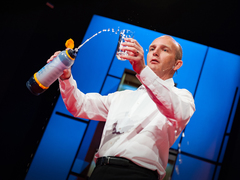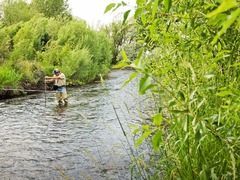[ted id=1660]
The glittering skyline of Doha, the capital of Qatar, has become famous in recent years. But as Fahad Al-Attiya points out in today’s talk, the ability for any city to grow in Qatar is surprising. After all, this is a country without any water.
Al-Attiya, the chair of Qatar’s National Food Security Programme, reveals that in the 1940s only about 11,000 people lived in Qatar — and there was no water or electricity. But in 1939, oil was discovered in the country and, after World War II, extraction of it began. Today, 1.7 million people live in Qatar and consume 430 liters of water per capita a year — one of the highest rates in the world.
But still, Qatar gets very little rainfall and no bodies of fresh water. Pointing at an image of desalination plant at work, Al-Attiya says, “That is our lake, that is our river … This is the best technology this region could have.”
Qatar has only two days worth of water reserve and imports 90 percent of its food, shares Al-Attiya. And this, of course, presents many risks. To hear how the nation is approaching these challenges — by putting to use the fact that they get 300 days of sunlight a year — listen to Al Attiya’s talk.
And below, six more talks on innovations for areas where water is a scarce resource.
 Anupam Mishra: The ancient ingenuity of water harvesting
Anupam Mishra: The ancient ingenuity of water harvesting
Anupam Mishra: The ancient ingenuity of water harvesting
Anupam Mishra: The ancient ingenuity of water harvestingIndia’s Golden Desert receives very little precipitation — just 9 inches a year — and its groundwater is 300 feet deep. As Anupam Mishra shares, this one case where old methods simply work better than newer technology. At TEDIndia 2009, he reveals the ingenious feats of engineering that were created centuries ago and are still in use today. |
 Michael Pritchard: How to make filthy water drinkable
Michael Pritchard: How to make filthy water drinkable
Michael Pritchard: How to make filthy water drinkable
Michael Pritchard: How to make filthy water drinkableMany, many people in the world get their water from unclean sources, making them highly susceptible to illness. Michael Pritchard has come up with a solution — a portable water-filtering bottle that can make highly contaminated water safe to drink. In this demo from TEDGlobal 2009, he has TED curator Chris Anderson test it out. |
 Ludwick Marishane: A bath without water
Ludwicke Marishane: Bath without water
Ludwick Marishane: A bath without water
Ludwicke Marishane: Bath without waterIn the small towns of Limpopo, South Africa, the water supply is as unpredictable as the weather. In this talk from TED@Johannesburg, young entrepreneur Ludwick Marishane tells the funny story of how he created DryBath, a cheap and convenient soap that doesn’t require water. Fun fact: He did the formula research and wrote his 40-page business plan all on his cell phone. |
 Damian Palin: Mining minerals from seawater
Damian Palin: Mining minerals from seawater
Damian Palin: Mining minerals from seawater
Damian Palin: Mining minerals from seawaterAccess to clean drinking water is a huge problem around the globe — and one of the most common solutions is desalination. But can we do anything with the salty material left behind in this process? In this talk from TED2012, Damian Palin shows how bacteria can interact with it and create minerals. His idea: biologically “mine” this desalination brine. |
 Rob Harmon: How to keep rivers and streams flowing
Rob Harmon: How the market can keep streams flowing
Rob Harmon: How to keep rivers and streams flowing
Rob Harmon: How the market can keep streams flowingThe United States may not seem like a place where water is scarce but, as Ron Harmon shares at TEDxRainer, streams and creeks are drying up because of over-usage. In this talk, he shares the story of Prickly Pear Creek, where beer makers — who use a ton of water in producing a single glass — and farmers are given incentives to turn back the damage. |
 Sonaar Luthra: Meet the Water Canary
Sonaar Luthra: Meet the Water Canary
Sonaar Luthra: Meet the Water Canary
Sonaar Luthra: Meet the Water CanaryAfter a disaster, it is far too hard to tell if the water is safe to drink, and thousands die as a result. TED Fellow Sonaar Luthra has createed a simple tool which can help, by testing water safety in seconds. At TEDGlobal 2011, he shares how this amazing Water Canary works. |
Comments (6)
Pingback: 18 TED Talks about teh base of the Abundance Pyramid | Change Agent Publications
Pingback: Wizmo Blog » Blog Archive » 7 talks on ideas for life without water